Are you considering installing artificial turf in your yard, but wondering if it’s truly eco-friendly? In this article, we will analyze the environmental impact of artificial turf and explore its water conservation benefits, energy consumption during production, and the role of chemicals used. We will also delve into how artificial turf affects wildlife habitats and soil health. Additionally, we’ll compare its carbon footprint to that of natural grass and discuss recyclability and disposal options. Stay tuned to make an informed decision about whether artificial turf aligns with your sustainability goals.
Environmental Impact of Artificial Turf
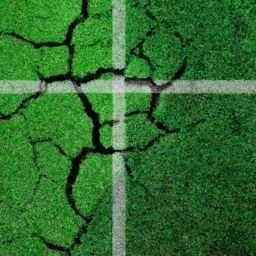
Artificial turf has been a popular choice for sports fields and landscapes due to its low maintenance requirements and perceived environmental benefits. One of the key advantages is its water usage benefits. Unlike natural grass, which requires regular watering to stay healthy, artificial turf does not need any irrigation. This can result in significant water savings, particularly in regions with limited water resources or during drought conditions.
In addition to conserving water, artificial turf also has the potential to reduce carbon emissions. The production of synthetic fibers used in artificial turf involves less energy compared to growing and maintaining natural grass. Furthermore, the absence of mowing eliminates the need for gasoline-powered lawnmowers, which contribute to greenhouse gas emissions.
However, it’s important to note that there are some potential drawbacks associated with artificial turf as well. For instance, the materials used in its construction often contain chemicals that can leach into the environment over time. Additionally, when exposed to high temperatures or direct sunlight, some types of artificial turf can release volatile organic compounds (VOCs), which may have negative effects on air quality.
Overall, while artificial turf offers certain environmental benefits such as reduced water usage and carbon emissions compared to natural grass fields or landscapes, it is essential to consider the potential long-term impacts on both land and air quality before making a decision.
Water Conservation Benefits of Artificial Turf
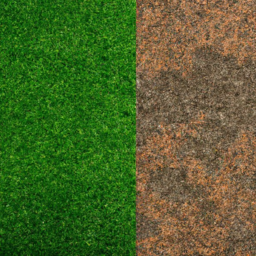
While it doesn’t require as much water as natural grass, artificial turf still helps conserve water. Compared to natural lawns, which typically need around 55 gallons of water per square foot per year, artificial turf can result in significant water savings. On average, a square foot of synthetic grass can save up to 55 gallons of water every year.
The potential harm caused by excessive water usage is evident when considering the current global water crisis. With increasing populations and climate change impacting freshwater availability, conserving water has become crucial. Artificial turf provides a practical solution for reducing our dependence on this precious resource.
Aside from its minimal watering needs, synthetic grass also eliminates the need for pesticides and fertilizers that are commonly used on natural lawns. These chemicals can contaminate groundwater and contribute to environmental degradation. By eliminating their use altogether, artificial turf reduces the risk of potential harm to both human health and the ecosystem.
Furthermore, artificial turf’s durability ensures that it maintains its lush appearance without requiring constant watering or maintenance. This means less time spent maintaining your lawn and more time enjoying it.
Energy Consumption in Artificial Turf Production
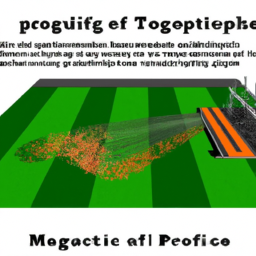
Compared to natural grass, the production of artificial turf requires less energy. Artificial turf is manufactured using synthetic materials like polyethylene or polypropylene, which are derived from petrochemicals. The production process involves melting and extruding these materials into yarns, which are then tufted onto a backing material. This manufacturing process consumes less energy compared to the constant watering, mowing, and fertilizing required by natural grass.
In terms of energy efficiency, artificial turf has an advantage over natural grass because it eliminates the need for regular maintenance activities that consume energy. With natural grass, you would need to use lawnmowers and other equipment regularly to keep it looking tidy. On the other hand, once artificial turf is installed properly, it requires minimal upkeep.
Additionally, artificial turf production has lower carbon emissions compared to maintaining a natural grass lawn. The manufacturing process may emit some greenhouse gases during the extraction and refinement of raw materials; however, this is offset by reduced carbon emissions from not having to mow or water the lawn regularly.
Considering its lower energy consumption during production as well as its reduced maintenance requirements compared to natural grass lawns, artificial turf can be considered more energy efficient and environmentally friendly alternative for outdoor spaces.
The Role of Chemicals in Artificial Turf
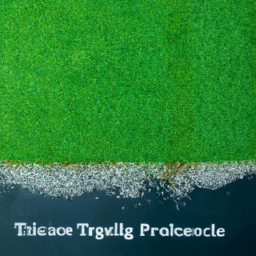
When considering the role of chemicals in maintaining your outdoor space, it is important to understand their impact on the environment. Pesticides play a significant role in keeping pests at bay and ensuring the health of your artificial turf. However, there are growing concerns about the potential health risks associated with their use.
Pesticides are commonly used to control weeds, insects, and other unwanted organisms that can damage or degrade artificial turf. These chemicals are designed to kill or repel pests, but they can also have unintended consequences for human health and the environment. Exposure to pesticides has been linked to various adverse effects such as respiratory problems, skin irritation, and even certain types of cancers.
To mitigate these concerns, it is crucial to use pesticides judiciously and follow proper application guidelines. This includes using appropriate protective equipment when handling pesticides and avoiding direct contact with treated turf surfaces. Additionally, choosing less toxic alternatives or natural methods of pest control can help minimize exposure to harmful chemicals.
Regular monitoring and maintenance of your artificial turf can also contribute to reducing reliance on pesticides. By properly managing water drainage, aerating the turf regularly, and addressing any underlying issues promptly, you can create conditions that discourage pests without resorting to chemical interventions.
Artificial Turf and Wildlife Habitats
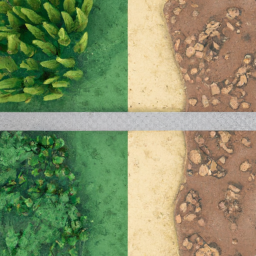
To create a welcoming habitat for wildlife in your outdoor space, consider incorporating native plants and providing natural food sources and shelter. Wildlife conservation is essential for maintaining biodiversity and ensuring the health of ecosystems. When it comes to artificial turf, however, its impact on wildlife habitats is a topic of concern.
Artificial turf is typically made from synthetic materials such as plastic fibers, rubber infill, and chemical additives. These materials do not provide the same benefits as natural grass or vegetation in terms of food sources and shelter for wildlife. Native plants, on the other hand, are adapted to local conditions and can attract a variety of insects, birds, and other animals that rely on them for survival.
The use of artificial turf may disrupt natural ecosystems by reducing the availability of suitable habitats for wildlife. It can also limit biodiversity by eliminating plant species that support diverse animal populations. Additionally, some studies have suggested that chemicals used in artificial turf may have negative effects on certain species.
Artificial Turf and Soil Health
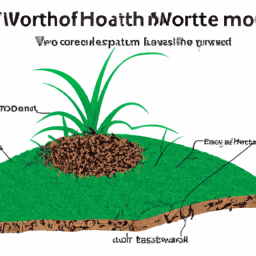
The impact of synthetic materials used in artificial turf on soil health is a topic of concern. Artificial turf is often made from materials such as polyethylene and polypropylene, which are not biodegradable. When these materials come into contact with the soil, they can leach harmful chemicals that may affect its composition and fertility.
One of the main concerns regarding artificial turf and soil health is water pollution. Synthetic materials used in artificial turf can release toxic substances when exposed to water, such as heavy metals and volatile organic compounds. These pollutants can infiltrate the soil and contaminate groundwater sources, leading to potential risks for both human health and ecosystem integrity.
Additionally, artificial turf may also impact carbon sequestration in soils. Natural grass helps absorb carbon dioxide from the atmosphere through photosynthesis, storing it in the form of organic matter in the soil. However, artificial turf does not possess this ability, potentially reducing the capacity of soils to sequester carbon.
Further research is needed to fully understand the long-term effects of artificial turf on soil health. It is crucial to develop alternative solutions that minimize potential negative impacts while still providing safe and sustainable options for sports fields or landscaping purposes.
Carbon Footprint of Artificial Turf
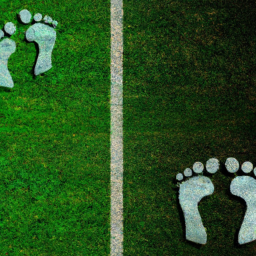
One concern with synthetic grass is its carbon footprint, as it may contribute to greenhouse gas emissions. Artificial turf production involves the use of fossil fuels and energy-intensive processes, leading to the release of carbon dioxide (CO2) and other greenhouse gases into the atmosphere. The manufacturing process requires extraction of raw materials like petroleum-based polymers and sand, which further adds to its carbon emissions. Additionally, transportation of artificial turf from manufacturing plants to installation sites also contributes to its overall carbon footprint.
However, it’s important to consider the sustainability benefits that artificial turf offers. Once installed, synthetic grass requires minimal water usage compared to natural grass lawns, reducing strain on local water resources. This can be especially beneficial in regions facing drought conditions or areas where water scarcity is a concern.
Furthermore, artificial turf eliminates the need for pesticides and fertilizers commonly used in maintaining natural lawns. These chemicals contribute to pollution in soil and water systems when they runoff during rainfall or irrigation. By eliminating their use, artificial turf helps reduce environmental contamination.
Overall, while artificial turf does have a carbon footprint associated with its production and transport, it also provides sustainability benefits such as reduced water usage and decreased reliance on harmful chemicals commonly used in lawn maintenance.
Recyclability and Disposal of Artificial Turf
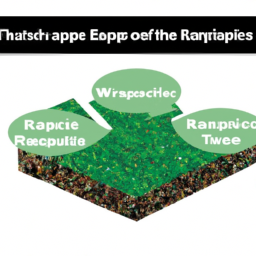
Recyclability and disposal options for synthetic grass should be considered to reduce its environmental impact. When it comes to the recyclability challenges of artificial turf, there are a few factors to consider. Firstly, the materials used in synthetic grass such as polyethylene and polypropylene are not easily recyclable due to their composition. These materials take a long time to break down and can release harmful chemicals when incinerated.
Disposal methods for artificial turf also present challenges. Landfilling is a common method of disposal, but this contributes to waste accumulation and takes up valuable space. Incineration is another option, but it releases greenhouse gases into the atmosphere, further contributing to climate change.
To address these challenges, efforts have been made towards finding more sustainable solutions for synthetic grass recycling and disposal. One approach is mechanical recycling, where the turf is shredded into small pieces and then processed into new products like plastic lumber or mats. Another option is chemical recycling, which involves breaking down the materials into their basic components for reuse in other applications.
Overall, while there are some challenges with recyclability and disposal of artificial turf, ongoing research and innovation are working towards developing more sustainable methods that can minimize its environmental impact. It’s important for manufacturers, consumers, and policymakers alike to prioritize these considerations in order to make artificial turf a more eco-friendly choice in the future.
Comparing Artificial Turf to Natural Grass in Terms of Environmental Impact
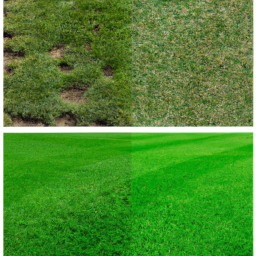
When comparing artificial turf to natural grass in terms of environmental impact, there are a few key factors to consider: water consumption and maintenance costs.
Firstly, let’s talk about water consumption. Natural grass requires regular watering to stay healthy and vibrant, especially in dry climates or during drought conditions. On the other hand, artificial turf doesn’t need any watering at all. This can lead to significant water savings over time, making it a more environmentally friendly option.
Now onto maintenance costs. Natural grass requires regular mowing, fertilizing, and pest control measures to keep it looking its best. These maintenance tasks not only require time and effort but also contribute to the use of chemicals that can be harmful to both humans and the environment. Artificial turf, on the other hand, needs minimal maintenance. Occasional brushing or sweeping is usually sufficient to keep it in good condition.
Frequently Asked Questions
How Does Artificial Turf Affect the Local Water Supply?
Artificial turf can have a significant impact on the local water supply. Due to its impermeable nature, it prevents rainwater from being absorbed into the ground, leading to increased runoff. This can result in water pollution and a strain on drainage systems. Additionally, artificial turf requires regular watering to remain green, further contributing to water consumption. These factors undermine water conservation efforts and can have negative economic consequences for communities that rely on a sustainable water supply.
What Is the Lifespan of Artificial Turf and How Does It Affect Its Environmental Impact?
The lifespan of artificial turf and its impact on the environment is an important aspect to consider. Artificial turf typically lasts between 10-20 years, depending on usage and maintenance. This longevity can have positive environmental benefits, as it reduces the need for constant replacement of natural grass fields. Additionally, artificial turf requires less water and eliminates the need for harmful pesticides or fertilizers. These factors contribute to a more eco-friendly alternative in sports fields and landscaping projects.
Are There Any Health Risks Associated With the Chemicals Used in Artificial Turf Production?
When considering the health risks of chemicals used in artificial turf production, it is essential to evaluate their impact on human well-being. Some studies suggest that certain chemicals found in artificial turf may have potential health risks, such as skin irritation or respiratory issues. However, it is crucial to note that proper installation and maintenance can minimize these risks. Additionally, from an environmental standpoint, artificial turf offers benefits such as water conservation and reduced pesticide use compared to natural grass.
How Does Artificial Turf Impact the Biodiversity and Ecosystem of the Area?
Artificial turf has significant ecological implications, particularly in terms of biodiversity conservation. The installation and maintenance of artificial turf can disrupt the natural ecosystems and harm local wildlife habitats. The use of pesticides and herbicides on artificial turf can also negatively impact insect populations and soil health. Additionally, the lack of natural vegetation on artificial turf reduces the availability of food sources for birds and other animals, further impacting biodiversity in the area.
Can Artificial Turf Be Recycled or Repurposed After Its Use?
When it comes to artificial turf, you might be wondering about its recycling options and repurposing possibilities. Well, after its use, artificial turf can indeed be recycled or repurposed in various ways. Recycling companies can process the materials and turn them into new products like mats or playground surfaces. Additionally, some organizations have found innovative ways to reuse the turf for landscaping or even as padding for sports fields. So, there are definitely options available to give artificial turf a second life after it’s no longer needed.
Conclusion
In conclusion, artificial turf has both positive and negative environmental impacts. While it conserves water and reduces energy consumption in the long run, its production involves the use of chemicals and may disrupt wildlife habitats. Additionally, the disposal of artificial turf poses a challenge due to its non-biodegradable nature. Comparing it to natural grass, artificial turf has a lower carbon footprint but lacks the soil health benefits provided by natural grass. Ultimately, weighing these factors is crucial when considering the eco-friendliness of artificial turf.